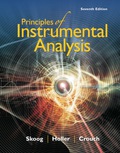
Principles of Instrumental Analysis
7th Edition
ISBN: 9781337468039
Author: Skoog
Publisher: Cengage
expand_more
expand_more
format_list_bulleted
Question
Chapter A1, Problem A1.13QAP
Interpretation Introduction
Interpretation:
First calculate the mean and standard deviation for each of the six data sets that are given and after that calculate the 95% confidence interval for each set of data.
Concept introduction:
95% of confidence interval can be calculated as follows when s is a good estimate of σ - CI=ˉx±zσ√N
Where
ˉx= Mean.
z= Function of quantity.
N= Degree of freedom
CI= Confidence interval.
Expert Solution & Answer
Want to see the full answer?
Check out a sample textbook solution
Students have asked these similar questions
pls help
24) Who suggested the first model of the atom that included more than one orbit for electrons?
Dalton
a.
b. Thomson
C.
Rutherford
d. Bohr
25) Which of the following compounds would be capable of hydrogen bonding?
a.
Ethanol
b. Hydrogen Sulfide
C.
Ethane
d. Carbon Dioxide
pls help
Chapter A1 Solutions
Principles of Instrumental Analysis
Ch. A1 - Prob. A1.1QAPCh. A1 - Prob. A1.2QAPCh. A1 - Prob. A1.3QAPCh. A1 - Prob. A1.4QAPCh. A1 - Prob. A1.5QAPCh. A1 - Prob. A1.6QAPCh. A1 - Prob. A1.7QAPCh. A1 - Prob. A1.8QAPCh. A1 - Prob. A1.9QAPCh. A1 - Prob. A1.10QAP
Ch. A1 - Prob. A1.11QAPCh. A1 - Prob. A1.12QAPCh. A1 - Prob. A1.13QAPCh. A1 - Prob. A1.14QAPCh. A1 - Prob. A1.15QAPCh. A1 - Prob. A1.16QAPCh. A1 - Prob. A1.17QAPCh. A1 - Prob. A1.18QAPCh. A1 - Prob. A1.19QAPCh. A1 - Prob. A1.20QAPCh. A1 - Prob. A1.21QAPCh. A1 - Prob. A1.22QAPCh. A1 - Prob. A1.23QAPCh. A1 - Prob. A1.24QAP
Knowledge Booster
Similar questions
- pls helparrow_forwardIndicate the compound resulting from the bromination of 3,5-dimethylpyrazolearrow_forward31) The reaction profile for a given chemical reaction is shown below A Energy Reactants Products B Progress of reaction a. Which arrow represents the activation energy for the forward reaction? b. Which arrow represents the activation energy for the backward reaction? c. Is the forward reaction exothermic or endothermic? d. Is the reverse reaction exothermic or endothermic?arrow_forward
- pls helparrow_forward10) What is the [OH-] concentration of a solution with a pH of 12.0? 1.0 x 10¹² M a. b. 1.0 x 10-12 M C. 1.0 x 10² M d. 1.0 x 102M 11) In which block of the periodic table would you find the element gold? a. b. s block P block C. d block d. f blockarrow_forward5) Who was responsible for the first model of the atom that included electrons? a. Dalton b. Thomson c. Bohr d. Rutherford 6) Which of the following rate laws is a fourth-order reaction? a. r = k[X][Y]²[Z] b._r= k[X]²[Y]³ C. r = k[X][Y]² d._r= k[X][Y]²[Z]ª 7) The activation energy of a particular reaction will decrease if: a. A catalyst is used. b. Temperature is increased. c. Reactant concentration is increased. d. All of the abovearrow_forward
- pls helparrow_forwardState the reason why compound A (m.p. 99-100°C) is heated under vacuum.1. So that the sample heating temperature is not too high when heated under vacuum.2. So that the temperature is higher than the melting point of compound A.3. So that cold water is not required in the sublimator.arrow_forwardTo find the theoretical % yield of a given reaction:1. actual amount obtained once crystallized2. (actual amount obtained / theoretical amount) x 1003. maximum amount of product that can be obtained / amount of initial reactantarrow_forward
- The reason activated carbon decolorizes and purifies a product is:1. It helps dissolve the product and then recrystallize it.2. It reacts with impurities in the product and removes them.3. It retains impurities by adsorption, purifying the product.arrow_forwardThe principle of a rotary evaporator is the same as that of:1. vacuum distillation2. reflux3. fractional distillationarrow_forwardAnhydrous MgSO4 is used to:1. Form a salt with the compound dissolved in the solution2. Remove water from a solution3. Neutralize a solutionarrow_forward
arrow_back_ios
SEE MORE QUESTIONS
arrow_forward_ios
Recommended textbooks for you
 Principles of Instrumental AnalysisChemistryISBN:9781305577213Author:Douglas A. Skoog, F. James Holler, Stanley R. CrouchPublisher:Cengage Learning
Principles of Instrumental AnalysisChemistryISBN:9781305577213Author:Douglas A. Skoog, F. James Holler, Stanley R. CrouchPublisher:Cengage Learning

Principles of Instrumental Analysis
Chemistry
ISBN:9781305577213
Author:Douglas A. Skoog, F. James Holler, Stanley R. Crouch
Publisher:Cengage Learning

